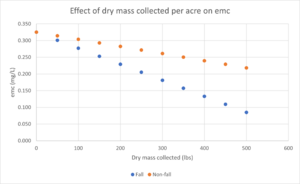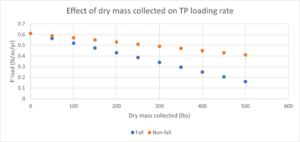
Accounting for phosphorus load reductions with street sweeping
Many stormwater models do not directly calculate reductions in phosphorus loading associated with street sweeping. P8 and WINSLAMM are exceptions. P8, however, bases phosphorus reductions on TSS reductions, which likely underestimates because most of the phosphorus loading is likely associated with organic debris. When reporting on phosphorus reductions, stormwater practitioners and permittees need to translate collection of street sweeping debris to a reduction in phosphorus loading.
This page provides some methods for accounting for phosphorus reductions associated with street sweeping.
You can use this simple spreadsheet to calculate changes in annual loading (lb/ac/yr) and event mean concentration associated with collection of material via street sweeping: File:Accounting for P adjustments.xlsx
Mass reduced
The simplest method for tracking reductions associated with sweeping is to estimate or measure the mass of phosphorus reduced. If tracking on a per acre basis is needed, the mass reduced must be determined per unit land area (e.g. per acre).
For example, using the MPCA Street Sweeping tool, assume the following data is collected. The resulting load reduction is 0.64 pounds of phosphorus, or 0.128 lb/ac/yr.
| Area swept (acres) | 5 |
| Dry mass collected (non-fall) | 500 |
| P reduction (non-fall) | 0.21 |
| Dry mass collected (fall) | 500 |
| P reduction (fall) | 0.43 |
| Total P reduced (lbs) | 0.64 |
| Loading rate reduction (lb/ac/yr) | 0.128 |
Loading (export) rates
As discussed above, annual phosphorus loading rates and changes in loading rate can be calculated knowing the mass reduced and the area. In the above example, an adjusted loading rate was calculated for a 5 acre area. One concern with calculating changes in loading rate is possible lumping and subsequent averaging of loading rates across an area where there are differences in loading rates within the area of concern. For example, if sweeper data across a city was used to estimate a loading rate, but there were significant differences in tree canopy cover across the city, the resulting loading rate represents a city-wide average and does not help identify areas where loading rates are higher or lower.
Adjusting emcs
If a model is being used to track phosphorus loading, reductions in mass can be used to adjust the event mean concentration (emc). These adjustments assume a linear relationship between mass of P reduced and the emc.
In the above example, the emc could be adjusted if the initial loading rate was known. For example, if the initial loading rate was 1.00 lb/ac/yr, the P reduction was 0.128 lb or 12.8 percent. The emc could be adjusted accordingly.
Because the emc adjustment is a function of the initial emc, it would be useful to establish relationships between sweeper mass collected and the resulting effect on emc for specific land uses that have a recommended default emc. For example, the MPCA Simple Estimator has a default of 0.325 mg/L TP for residential land use. Using the default values of 30.65 in/yr precipitation and 0.27 for runoff coefficient, the resulting annual TP load is 0.61 lb/ac/yr. We ran several scenarios using the MPCA Sweeping Tool and established relationships between sweeper mass collected (dry mass) and the effect on emc and loading rate. The results are shown in the adjacent figures. Similar relationships could be established for other land uses that have recommended emcs.
Effects of model inputs
When calculating changes in loading rates it is best to utilize dry weight measurements and, if possible, locally determine the average total phosphorus concentration in the material collected. Wet mass measurements are likely to lead to greater potential error since moisture content varies throughout the year and with the type of material being collected (e.g. mineral or organic).
This page was last edited on 24 August 2022, at 20:26.

